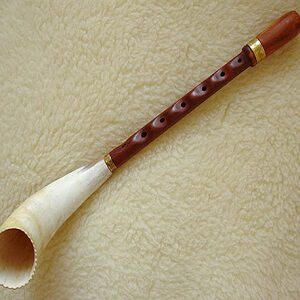Hornpipe
 The original Hornpipe was a musical instrument — in this context it is a cylindrical bore wooden instrument with finger holes like a recorder or tin whistle, an animal horn bell (widening cone at the bottom) and animal horn mouthpiece to accommodate a single beating reed, as used in a bagpipe chanter. It's been around since medieval times, and considered obsolete (in polite society anyway) by 1600 or so.
The original Hornpipe was a musical instrument — in this context it is a cylindrical bore wooden instrument with finger holes like a recorder or tin whistle, an animal horn bell (widening cone at the bottom) and animal horn mouthpiece to accommodate a single beating reed, as used in a bagpipe chanter. It's been around since medieval times, and considered obsolete (in polite society anyway) by 1600 or so.
he most common instrument in the British Isles of this description is the Welsh pibcorn. The single beating reed (not quite the same as a clarinet reed) is actually identical to the drone reed used in most types of bagpipes. Historically the reeds were either made from arondo donex cane or fashioned from small elder branches; makers still use these materials. The earliest hornpipe bodies were made out of cane, and there are hornpipe-type instruments from North Africa and the Middle East that are still made that way. Most British Isles varieties of hornpipes were made of wood. In all cases, the total bore of the instrument was cylindrical in nature, with the animal horn used as a bell for amplification. Many varieties have a horn mouthpiece over the reed; in other varieties the reeds were actually put in the mouth directly.
Some medieval and Renaissance hornpipes had the reed fully enclosed by the animal horn, making it a “capped single-reed” instrument, in contrast to that beloved (by early musickers at least) buzzy, the krumhorn, which has a capped double reed (like a bassoon).